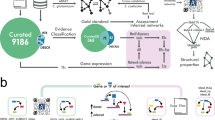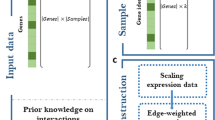Abstract
Nitrogen is an essential nutrient for all life forms. Like most unicellular organisms, the yeast Saccharomyces cerevisiae transports and catabolizes good nitrogen sources in preference to poor ones. Nitrogen catabolite repression (NCR) refers to this selection mechanism. We propose an approach based on Gaussian graphical models (GGMs), which enable to distinguish direct from indirect interactions between genes, to identify putative NCR genes from putative NCR regulatory motifs and over-represented motifs in the upstream noncoding sequences of annotated NCR genes. Because of the high-dimensionality of the data, we use a shrinkage estimator of the covariance matrix to infer the GGMs. We show that our approach makes significant and biologically valid predictions. We also show that GGMs are more effective than models that rely on measures of direct interactions between genes.
This work was supported by the Communauté Française de Belgique (ARC grant no. 04/09-307).
Preview
Unable to display preview. Download preview PDF.
Similar content being viewed by others
References
Godard, P., Urrestarazu, A., Vissers, S., Kontos, K., Bontempi, G., van Helden, J., André, B.: Effect of 21 different nitrogen sources on global gene expression in the yeast Saccharomyces cerevisiae. Molecular and Cellular Biology 27, 3065–3086 (2007)
Scherens, B., Feller, A., Vierendeels, F., Messenguy, F., Dubois, E.: Identification of direct and indirect targets of the Gln3 and Gat1 activators by transcriptional profiling in response to nitrogen availability in the short and long term. FEMS Yeast Research 6, 777–791 (2006)
Kontos, K., Godard, P., André, B., van Helden, J., Bontempi, G.: Machine learning techniques to identify putative genes involved in nitrogen catabolite repression in the yeast Saccharomyces cerevisiae. BMC Proceedings 2, S5 (2008)
Lauritzen, S.L.: Graphical Models. Oxford Statistical Science Series. Clarendon Press, Oxford (1996)
Simonis, N., Wodak, S.J., Cohen, G.N., van Helden, J.: Combining pattern discovery and discriminant analysis to predict gene co-regulation. Bioinformatics 20, 2370–2379 (2004)
Schäfer, J., Strimmer, K.: A shrinkage approach to large-scale covariance matrix estimation and implications for functional genomics. Statistical Applications in Genetics and Molecular Biology 4, 32 (2005)
Dobra, A., Hans, C., Jones, B., Nevins, J., Yao, G., West, M.: Sparse graphical models for exploring gene expression data. Journal of Multivariate Analysis 90, 196–212 (2004)
Castelo, R., Roverato, A.: A robust procedure for Gaussian graphical model search from microarray data with p larger than n. Journal of Machine Learning Research 7, 2621–2650 (2006)
Magwene, P., Kim, J.: Estimating genomic coexpression networks using first-order conditional independence. Genome Biology 5, R100 (2004)
Wille, A., Zimmermann, P., Vranová, E., Fürholz, A., Laule, O., Bleuler, S., Hennig, L., Prelić, A., von Rohr, P., Thiele, L., Zitzler, E., Gruissem, W., Bühlmann, P.: Sparse graphical Gaussian modeling of the isoprenoid gene network in Arabidopsis thaliana. Genome Biology 5, R92 (2004)
Kontos, K., Bontempi, G.: Nested q-partial graphs for genetic network inference from “small n, large p” microarray data. In: Elloumi, M., Küng, J., Linial, M., Murphy, R., Schneider, K., Toma, C. (eds.) BIRD 2008. CCIS 13, pp. 273–287. Springer, Heidelberg (2008)
Ledoit, O., Wolf, M.: A well-conditioned estimator for large-dimensional covariance matrices. Journal of Multivariate Analysis 88, 365–411 (2004)
Cooper, T.G.: Transmitting the signal of excess nitrogen in Saccharomyces cerevisiae from the Tor proteins to the GATA factors: connecting the dots. FEMS Microbiology Reviews 26, 223–238 (2002)
Bar-Joseph, Z., Gerber, G., Lee, T., Rinaldi, N., Yoo, J., Robert, F., Gordon, D., Fraenkel, E., Jaakkola, T., Young, R., et al.: Computational discovery of gene modules and regulatory networks. Nature Biotechnology 21, 1337–1342 (2003)
Butte, A., Tamayo, P., Slonim, D., Golub, T., Kohane, I.: Discovering functional relationships between RNA expression and chemotherapeutic susceptibility using relevance networks. Proceedings of the National Academy of Sciences 97, 12182–12186 (2000)
Whittaker, J.: Graphical Models in Applied Multivariate Statistics. John Wiley and Sons, Inc., Chichester (1990)
Edwards, D.: Introduction to Graphical Modelling, 2nd edn. Springer Texts in Statistics. Springer, Heidelberg (2000)
Schäfer, J., Strimmer, K.: An empirical Bayes approach to inferring large-scale gene association networks. Bioinformatics 21, 754–764 (2005)
Dykstra, R.: Establishing the positive definiteness of the sample covariance matrix. The Annals of Mathematical Statistics 41, 2153–2154 (1970)
van Helden, J.: Regulatory sequence analysis tools. Nucleic Acids Research 31, 3593–3596 (2003)
Provost, F., Fawcett, T., Kohavi, R.: The case against accuracy estimation for comparing induction algorithms. In: Proceedings of the Fifteenth International Conference on Machine Learning, pp. 445–453. Morgan Kaufmann, San Francisco (1998)
Fawcett, T.: An introduction to ROC analysis. Pattern Recognition Letters 27, 861–874 (2006)
McClish, R.J.: Analyzing a portion of the ROC curve. Medical Decision Making 9, 190–195 (1989)
Jiang, Y.L., Metz, C.E., Nishikawa, R.M.: A receiver operating characteristic partial area index for highly sensitive diagnostic tests. Radiology 201, 745–750 (1996)
Efron, B.: Nonparametric estimates of standard error: the jackknife, the bootstrap and other methods. Biometrika 68, 589–599 (1981)
Author information
Authors and Affiliations
Editor information
Editors and Affiliations
Rights and permissions
Copyright information
© 2009 Springer-Verlag Berlin Heidelberg
About this paper
Cite this paper
Kontos, K., André, B., van Helden, J., Bontempi, G. (2009). Gaussian Graphical Models to Infer Putative Genes Involved in Nitrogen Catabolite Repression in S. cerevisiae . In: Pizzuti, C., Ritchie, M.D., Giacobini, M. (eds) Evolutionary Computation, Machine Learning and Data Mining in Bioinformatics. EvoBIO 2009. Lecture Notes in Computer Science, vol 5483. Springer, Berlin, Heidelberg. https://doi.org/10.1007/978-3-642-01184-9_2
Download citation
DOI: https://doi.org/10.1007/978-3-642-01184-9_2
Publisher Name: Springer, Berlin, Heidelberg
Print ISBN: 978-3-642-01183-2
Online ISBN: 978-3-642-01184-9
eBook Packages: Computer ScienceComputer Science (R0)




